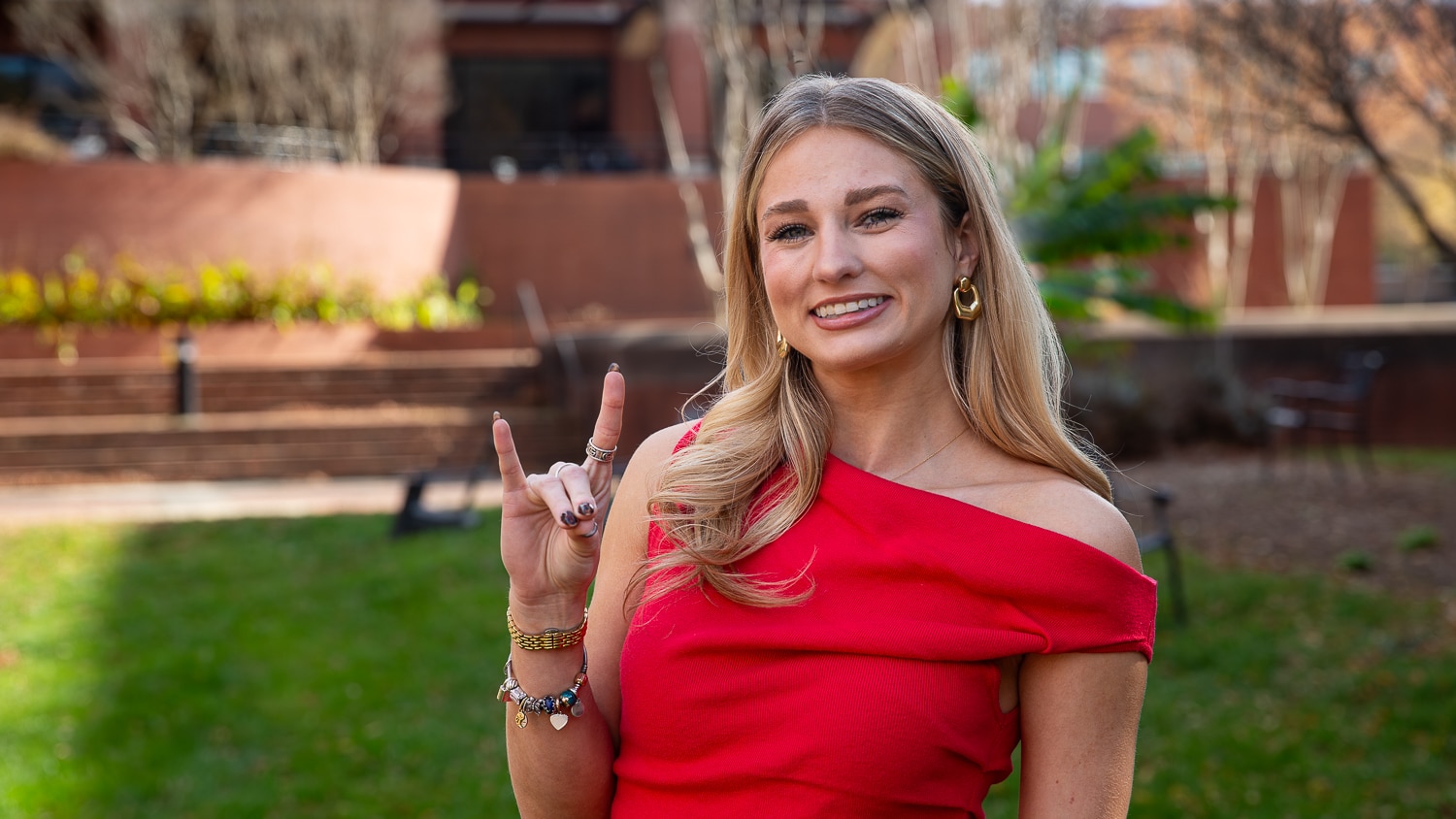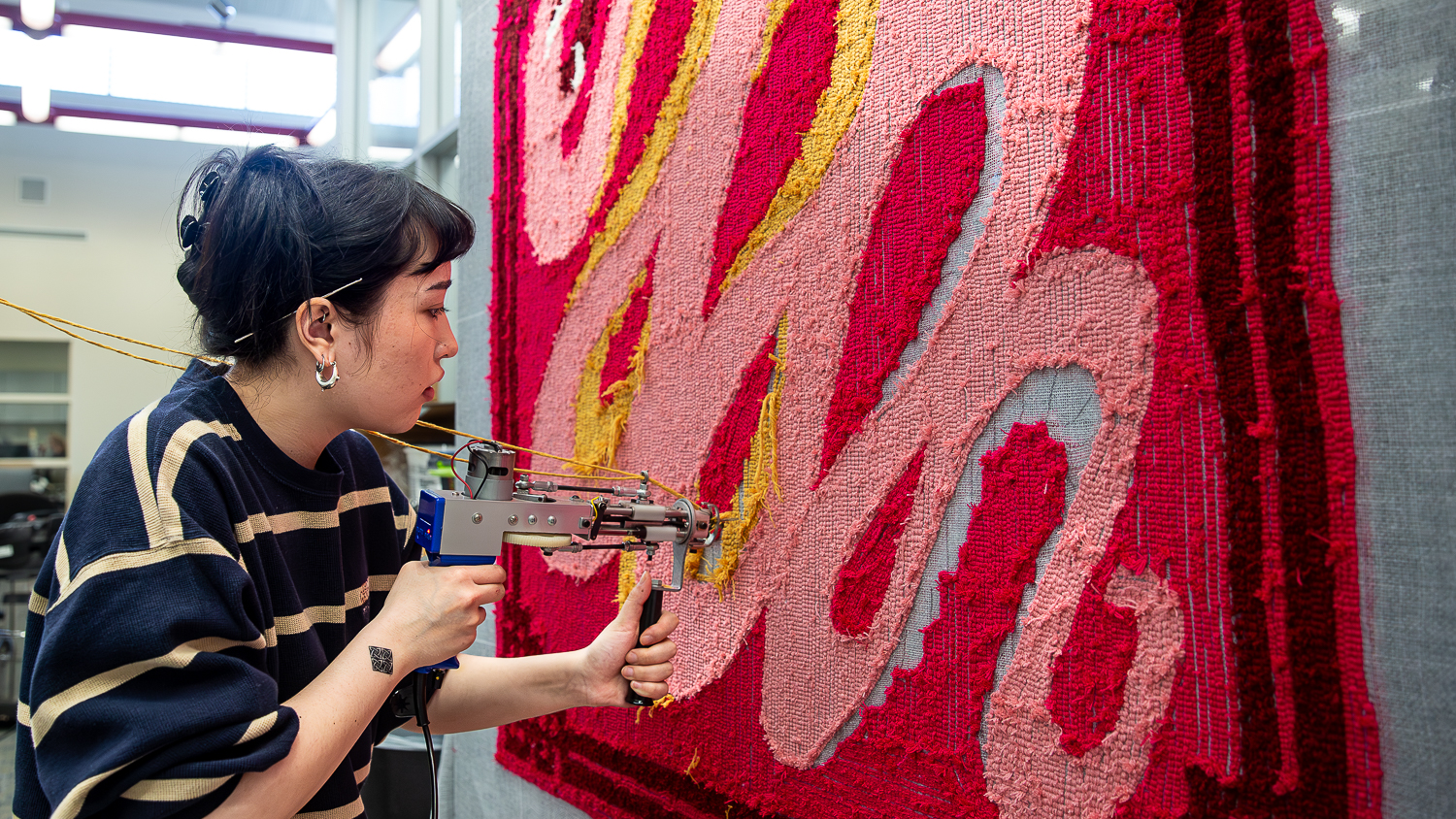NC State Shapes What’s Next in Interiors at High Point Market
Textile design students and alumni at the Wilson College of Textiles bring a unique perspective to the event, which draws industry leaders from around the world.

Interior design trends gain popularity with the general public through platforms like Pinterest and Architectural Digest, but they make their true industry debut just up the road from NC State at the High Point Market.
Twice a year, the small city of High Point, North Carolina (population 116,000), welcomes over 75,000 visitors from 100+ countries around the world. Over 2,000 exhibitors show off the newest in high end homewares to interior designers, fabric designers, influencers and other key members of the industry.
Across the 11.5 million square feet of showroom space, you’ll find textile design students and alumni from the Wilson College of Textiles putting their education to work.

Approaching interior design with a textile perspective
Among that group is Britt Warner ’20: junior designer and project manager with Liles Dunnigan Interiors.
“I help Liles out with everything from picking out fabrics for a design or paint colors to ordering and project management for our client work,” she says.
For Warner and other interior designers, Market is an opportunity to find the best items for upcoming projects and current clients.

“We go to source stuff, but we walk away knowing about trends: what’s good, what’s bad, what’s not working? Maybe there was a big trend that we saw a ton of last season, but didn’t see a ton of this season,” she says.
And while textiles are only part of the equation, Warner believes her knowledge of these materials has provided her with a unique advantage as an interior designer.
“I know things that other people don’t know in the industry. I have to consider how a fabric is going to wear over time probably four times a day, and I can determine that without having to look into the abrasion resistance or anything because I know the fiber,” Warner says. “I know and I can look at the weave construction and easily see whether or not that fabric is likely to pick or snag.”

Textile design student and aspiring interior designer Anna Oliver attended Market through her internship with Lauren McKay Interiors. She says her textile design background is already opening the door to new opportunities.
“I’ve done a lot of the typical intern stuff, like organizing the fabric rooms and keeping up with the studio. But Lauren has also let me do some fabric sourcing, which has been exciting. So I’ve had the chance to go through Kravet and Schumacher to pick out and order fabrics from their newest collections that I think would work with her design style, which has been fun,” she says. “I think she appreciates my textile design side, so she knows I have an eye for that.”
Oliver attended Market a few years ago as an intern for a fabric manufacturer, but this was her first visit as an interior design intern. She says she learned a lot from seeing how different interior designers approached the use of textiles in their showrooms.



“A bunch of the designers I saw used similar fabrics, but they would do it differently,” she says. “It was cool seeing different styles of interior design realized with the same textiles.“
While she may only be a few years into her degree, Oliver has already noticed the way her textile background impacts her approach as an aspiring interior designer.
“I think it’s really helped give me an advantage with interior design. It’s so beneficial to not only be able to see color and pattern in a different way, but also be able to apply it in end uses eventually. I tend to base my room designs off of intricate patterns. I feel like I tend to start with pattern and color now instead of starting with a piece of furniture. That’s a design perspective that I feel not everyone has.”
Student organization provides valuable opportunities
Not all students got access to Market through an internship. More than half a dozen students traveled to High Point as part of the college’s WithIt student chapter to connect with other students and current industry professionals. WithIt (Women in the Home Furnishings Industry Today) is a professional organization that focuses on mentoring and professional development opportunities for women working in roles from textile design to supply chain and marketing.
Their Student Mentoring Day included a panel discussion and roundtable sessions that provided real-world advice about the job search, adjusting to challenges in the supply chain and more. Afterwards, Withit mentors gave students a tour of the showrooms.

Textile design senior Shayleigh Larsen is the president of the Wilson College’s WithIt student chapter. She says her main takeaway from this year’s panel was the importance of understanding how new technologies, like AI, can be applied to day-to-day operations.
“If you start focusing on how this technology is being incorporated, it makes you very valuable to a lot of these companies, especially because they see you as someone who can teach the rest of the company,” she explains.
The event also gives Wilson College students the chance to make valuable connections with alumni working in the field, like Colby Hopper. As a textile designer for Sunbrella, Hopper plays a role in developing fabrics for major retailers like Pottery Barn and Ballard Designs, catalogs, and even independent artists looking for collaborations. She translates customer artwork into a woven fabric that has both the aesthetic and performance attributes needed for the product.

“I’m using my knowledge of different weave constructions and making sure that the fabric will end up holding up to our client’s standards,” Hopper (B.S. FTD ’21, M.S. Textiles ’23) explains.
She hosted a roundtable discussion sharing her experience on the job hunt as a recent graduate to help current students land their first job.
“I just tried to put myself in their shoes again, sitting on the other side of the table and give them the best advice I could,” she says.

Her biggest piece of advice to students planning to enter the field? Realize just how many opportunities are open to you.
“You don’t have to have it all figured out right after graduation. While it’s helpful to have a plan, remember that you have your whole life to explore different paths and discover what truly excites you. There are so many opportunities in the furniture industry that are in the state. Be open to trying new things, and let your passions lead you to exciting opportunities.”
- Categories:


